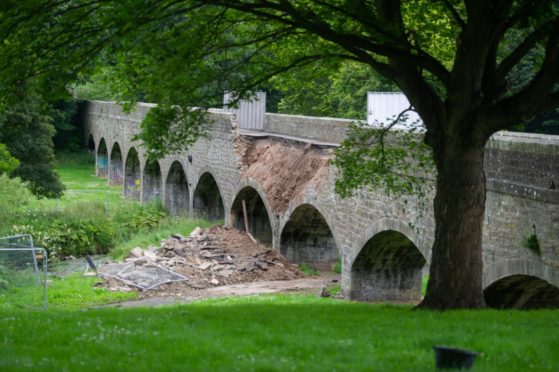A historic Dundee footbridge which collapsed is set to be fully restored.
Part of Finlathen Viaduct crumbled due to water saturation in the summer of 2019 but a £700,000 project to finish rebuilding it will likely be approved on Monday.
The Dighty Burn link is already being repaired south of the water but the second phase will see the northern side fixed too.
Locals had feared in would be knocked down if deemed too expensive to repair.
Ron Neave, from Fintry Community Council, said he is delighted to hear of the 13-arch bridge’s restoration.
He said: “Without a doubt we are happy about this.
“It was well-used before its collapse and I think it will be once it’s fixed.
“I imagine it will take some time before it’s open again. The problem with these things is the longer it takes to fix it, the more difficult it usually becomes.
“Unfortunately these things cost a lot of money too.”
‘Much-loved landmark’
The 175-year-old viaduct passes over Finlathen Park and connects the communities of Fintry and Linlathen.
It was shut suddenly in July 2019 after a bulge appeared in a section of the wall.
But following torrential rain just weeks later, the southern section crumbled into an embankment below.
On Monday councillors at the city development committee will be asked to approve a bid by local contractors Dundee Plant Co Ltd to carry out the work.
Steven Rome, depute convener of the committee, said: “We know that the bridge is a much-loved landmark in that part of the city and after some careful consideration when it was damaged a couple of years ago it was decided to reinstate it.
“That work is due to finish soon and in order to ensure the bridge’s structure is sound along its entire length, a tender to carry out a second phase of work on it to the north of the Dighty was put out.”
It was built between 1846 and 1847 as a means of carrying the first water pipeline from Monikie over the Dighty valley to Dundee.
It was originally covered with turf to keep the pipes cool in the summer and above freezing in winter.
Around 100 years later it was converted into a footpath with tarmac after residents asked for a viable route over the burn.
